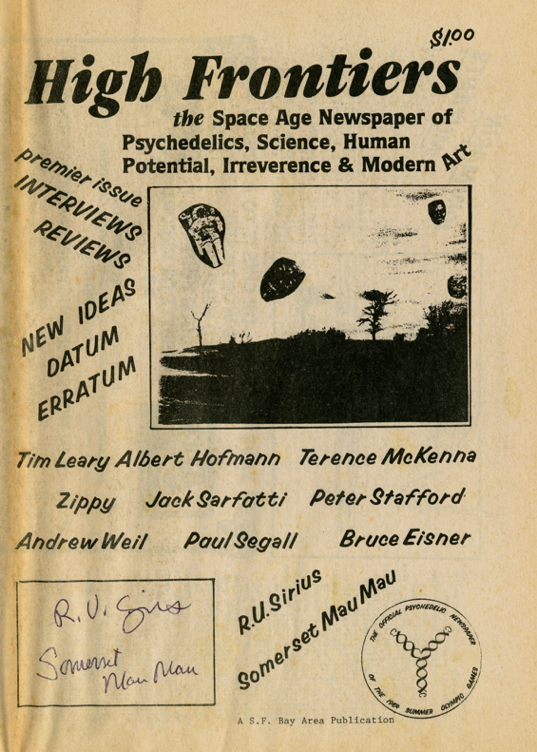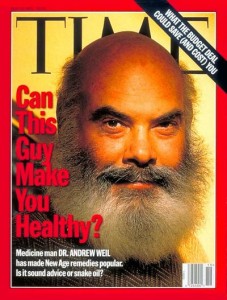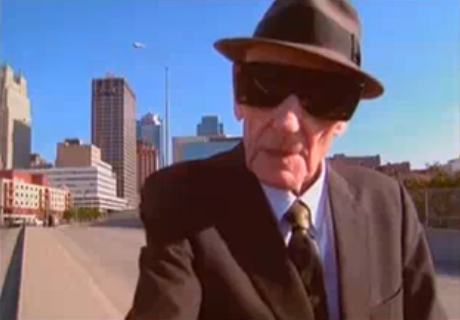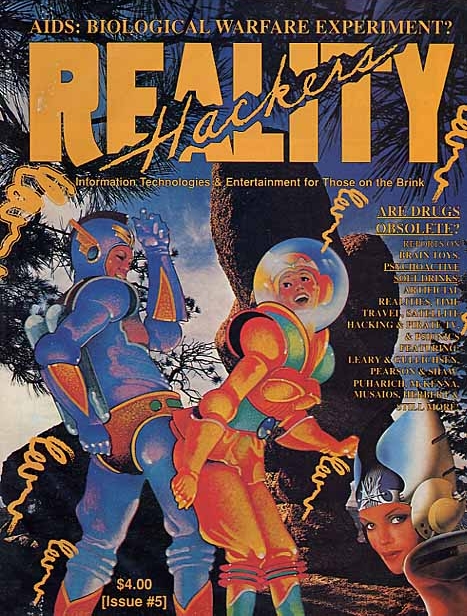
Of all the weird jobs I’ve had in my life, the most entertaining was probably a floor managing gig I took in the early 2000s at a metaphysical shop called Gateways Books. In a town known for its high WTF factor — Santa Cruz, CA — this place was quite possibly WTF Headquarters. Gateways was a magnet for a vast panoply of enlightenment seekers, occultists and countercultural characters of all strains: Buddhist monks, cult escapees, Shiva worshippers, black magicians, clairvoyants, pagan priestesses, psychedelic trippers, channelers, Tantrists, breatharians, Silence of the Lambs-style cross-dressers in smeared black makeup, etc., etc.
Ah, how I loved all these Star Wars cantina creatures and their endlessly unpredictable antics. I routinely feasted on wildly original ideas from some of the most unique characters on the planet, such as the shaven-headed fellow who vigorously explained that to be 5150 (police code for crazy) was to be greater than 100% ( i.e., greater than 50/50), or the numerologist/rune expert who pontificated at length about the metaphysical links between the faerie archetype and the actress Fay Wray (fay-ray: get it?) and between comedienne Minnie Pearl and the New Testament’s “Pearl of Great Price.†(“You see, Minnie Pearl came from Memphis, and the rune for ‘Mem’ has a numerical value of 14, which, when divided by the numerical value of the rune for ‘Phis’ and then multiplied by the number of the Goddess, comes out to Minnie Pearl’s street address, which also happens to be the last three digits of my phone number.†That kind of thing.)
To me, the customers who didn’t fit the profile of the calm, soft-spoken “spiritual†type often came off as more legitimately mystical than the ones who did. Many of the by-the-book types (in honor of whom I sometimes called the store Getwise Books in secret) appeared to be wearing spirituality like a temporary tattoo, whereas the rowdies and crackpots seemed more like thrill seekers who had accidentally crashed their hang gliders into realms of higher consciousness.
On any given day at Gateways, you might witness a disheveled store patron sending himself into orgasmic ecstasy by pressing an AA battery against his teeth, or you might hear a self-professed UFO abductee impassionedly extolling the virtues of hooking a crystal up to a car battery and then placing it to your forehead. One regular customer, a secret societies aficionado who used an expensive array of radionic devices to achieve spiritual contact with the ’80s pop singer Tiffany, was interesting enough to earn a starring role in the stunningly strange documentary film I Think We’re Alone Now, which can and should be watched streaming via Netflix or here. And trust me: when two or more of these characters interacted with one another, it was epic viewing on par with Abbott & Costello Meet Frankenstein or Godzilla vs. Mothra.
The job perks weren’t bad, either: on one occasion, a Hindu man in a saffron robe gave me a dried pineapple ring that left me feeling oddly elated, and on another, a friendly Buddhist raver kid handed me a freshly picked mushroom that gave me an almost religious appreciation for the magnificent precision instrument known as the human eye.
One afternoon, a tall, frighteningly animated guy from L.A. burst through the front door, startling the entire shop—and quite possibly a few wild beasts of the Serengeti—with his overpoweringly loud voice. “HEY, BRO!†he shouted. “DO YOU HAVE A BOOK CALLED ‘PLANTS OF THE GODS’?â€
After taking a moment to peruse our computer records, I responded affirmatively. The customer—let’s call him Taz—assimilated this information by jumping around as if he had a spider in his sock. “NO FUCKING WAY!†he bellowed. “ARE YOU SERIOUS? NO, MAN, YOU DON’T UNDERSTAND—I’VE BEEN LOOKING ALL OVER THE COUNTRY FOR THIS BOOK! I CAN’T BELIEVE YOU’VE GOT IT!â€
Speaking in the most soothing tones I could find in my voice box, I led him to the Psychedelics section, where the book in question lay in wait. Letting out a victory yelp, he seized his prize and feverishly thumbed through its pages. Within seconds, he zeroed in on a colorful painting of a bulls-eye pattern with a flower petal-like border. “YOU SEE THIS RIGHT HERE?†he demanded, seemingly on the verge of gouging out his own eyes with excitement. “I SAW THIS! I SAW THIS!!â€
Now, it so happened that the man standing to our immediate right was dressed as a druid. Not a cheap, Halloween-style facsimile, mind you—this guy was a real-deal, straight-outta-Rivendell, fireball-hurling badass, complete with staff, white beard, black cloak and hand-crafted metal bracelets. (We’ll call him Draco.) With the calm, knowing air of a learned magus, he turned toward us and intoned, “I’ve seen it, too. But not just those circles.†He waved the extremely long nail of his index finger toward a gaggle of animals and spirits surrounding the bulls-eye pattern. “All this as well.†With an extra measure of wizardly self-assurance, he added, “Did you know you can go inside those circles you saw?â€
Taz completely lost his shit. “I DID!! And then I heard this SOUND…â€
“Stop right there,†Draco cut in. “It was one of two sounds.†He emitted a low, metallic rumble that sounded something like a robot playing a didjeridoo. This didn’t seem to ring a bell with Taz. But when he switched to a high-pitched space probe whir, he hit pay dirt. “THAT!!†Taz screamed.
Unsurprised by his success, Draco pressed on: “And did you meet… Them?†He leaned forward slightly, smiling conspiratorially. “Do you know what I mean by ‘Them’?â€
“Ohhhhhhhhh, yeah! Ohhhhhhh, yes I do, bro!†The assurance in Taz’s tone left no question that he knew exactly what Draco meant, and that he had, in fact, encountered “Them.†Fighting the urge to raise my hand and say, “Huh?â€, I listened raptly as the two trippers journeyed into conversational terrain where I could no longer follow.
“Waaaaiiiiitttt a second, bro,†Taz interjected. “Did we have the same catalyst for this?â€
“Probably,†Draco replied. There was a momentary pause, and then, with an uncanny similitude of timing, pitch and inflection that had to be heard to be believed, they both blurted out, “DMT.â€
It was a magical moment. Everyone within earshot of the conversation, including Taz and Draco, burst into laughter at the perfection of the synchrony. Eccentricity aside, there was something undeniably powerful going on here.
The conversation lingered on my mind for days afterward. Could DMT be a guest pass to hidden dimensions with an objective existence? And what, exactly, had Draco meant by “Them�
Only much later, after skimming Rick Strassman’s DMT: The Spirit Molecule and listening to some rants by Terence McKenna, would I learn the answer to the latter question. “They,†as many readers already know, are the otherworldly beings that an astounding number of experimenters claim to have encountered while under the influence of DMT. Most such claimants are convinced that the DMT entities are not aspects of their own psyches, but are in fact independently existing denizens of a domain completely alien to our understanding. One popular theory is that DMT is a portal to the afterworld, and the entities are none other than spirits of those who have crossed over.
From an outsider’s perspective, there is, of course, a much simpler explanation: we have here a situation where the question “What have you been smoking?†doesn’t even need to be asked. This would be an easy position to take were it not for the astonishing consistency with which certain archetypes show up in different people’s DMT visions. Among the most common of these figures are insectoid aliens that perform some sort of surgery and/or testing on the tripper, and playful, self-transforming “elves†or “gnomes,†many of which offer the DMT voyager inscrutable objects that they’ve created by way of some kind of visible language. I personally have talked with folks whose descriptions of their own experiences of entity contact perfectly matched the stories I’ve read, in spite of the fact that some of these people had never heard of “Them†before smoking DMT.

Former Trip Magazine publisher James Kent has proposed that the entities are the product of DMT’s disruption of our visual processing: being anthropomorphically oriented by nature, the brain tries to find order in the chaos by sculpting the neural static into humanoid figures. Seems reasonable enough, though it doesn’t explain the regularity with which incredibly specific visions occur (surgical scenes, for example), nor does it account for all the highly intelligent DMT users who have undoubtedly entertained this hypothesis, yet who still insist that there’s something more going on here.
If you went back to the 15th century with a microscope and told folks that this piece of plastic and glass was a gateway to some kind of secret domain where various odd-shaped critters were moving around, they’d have called you crazy. Similarly, the very idea that you and someone in another country can see these words at the same time probably would have seemed insane, impossible or magical to pre-electronic civilizations. Perhaps DMT is a kind of “technology†that provides access to data that our primitive 21st century minds just aren’t capable of comprehending.
Getting back to the shop: Gateways is no more; in 2011, the recession forced the place to shut its doors after 32 years of service to the AA battery-munching community. I can’t imagine where I’ll ever find another gathering place for such a colorful assembly of otherworldly beings.
Oh, wait a second — yes, I can…











































